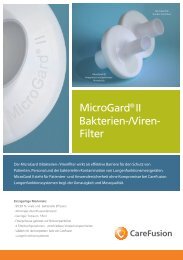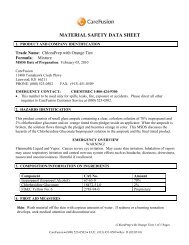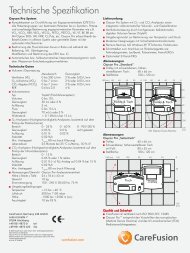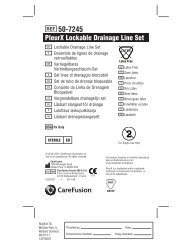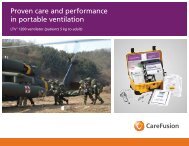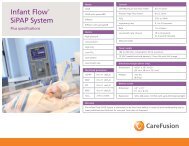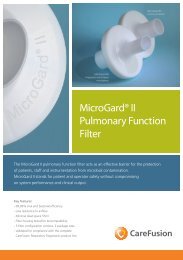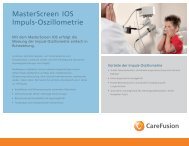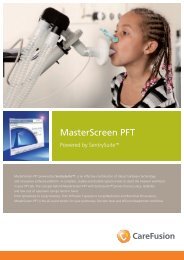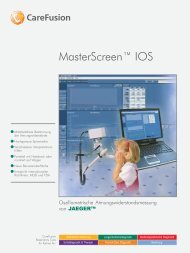PleurX Drainage Procedure - CareFusion.de
PleurX Drainage Procedure - CareFusion.de
PleurX Drainage Procedure - CareFusion.de
You also want an ePaper? Increase the reach of your titles
YUMPU automatically turns print PDFs into web optimized ePapers that Google loves.
<strong>PleurX</strong> <strong>Drainage</strong> Supplies<br />
The following supplies are required to complete a drainage<br />
procedure: (Figure 2)<br />
1 Plastic Vacuum Bottle with attached <strong>Drainage</strong> Line<br />
1 <strong>Procedure</strong> Pack containing the following sterile items:<br />
1 Self-Adhesive Dressing (A)<br />
Blue Wrapping (Wrapped around the following Items) (B)<br />
3 Alcohol Pads (C)<br />
1 Pair of Gloves (D)<br />
1 Valve Cap (E)<br />
1 Blue Emergency Sli<strong>de</strong> Clamp (F)<br />
4 Gauze Pads 4” x 4” (10 cm x 10 cm) (G)<br />
1 Foam Catheter Pad (H)<br />
How to Drain Using the <strong>PleurX</strong> <strong>Drainage</strong> Kit<br />
Now that your doctor or nurse has trained you on the drainage<br />
procedure, you should find it easy to follow these step-by-step<br />
instructions. You should drain as directed by your doctor,<br />
usually every one to two days. Do not change frequency or<br />
drain more fluid than your doctor has recommen<strong>de</strong>d without<br />
first consulting your doctor.<br />
Prepare to Drain<br />
1. Set up a clean, clear workspace on a table or counter.<br />
2. Place the number of bottles that you plan on using near<br />
your workspace.<br />
3. Thoroughly wash your hands with soap and water for at<br />
least 1 minute.<br />
4. Remove the dressing from over your catheter. If you see<br />
any redness, swelling or fluid around the catheter, finish<br />
this drainage procedure and contact your doctor or nurse.<br />
5. Thoroughly wash your hands again with soap and water for<br />
at least 1 minute.<br />
6. Open the <strong>Drainage</strong> Kit bag and remove the <strong>Procedure</strong> Pack<br />
pouch.<br />
7. Open the <strong>Procedure</strong> Pack pouch. Set the adhesive dressing<br />
asi<strong>de</strong>.<br />
8. Set bundle with blue wrapping on your workspace with the<br />
flap si<strong>de</strong> up. Carefully unfold the blue wrapping by pulling<br />
on the outsi<strong>de</strong> of the wrapping. Leave the enclosed items<br />
on the wrapping. The items and the insi<strong>de</strong> of the wrapping<br />
are sterile. Do not touch them with your ungloved hands or<br />
other non-sterile items. (Figure 4)<br />
9. Remove the bottle with the drainage line from the bag.<br />
The items in the drainage kit bag are sterile. It is especially<br />
important that the access tip remain sterile. If the cover<br />
has fallen off of the access tip, make sure you do not touch<br />
the tip with your hands or anything non-sterile. The access<br />
tip can only touch the blue wrapping.<br />
10. Set bottle near blue wrapping, remove the paper tape from<br />
the drainage line and uncoil the drainage line. Place the<br />
access tip on the blue wrapping.<br />
11. Both gloves fit either hand. Be careful not to let the outsi<strong>de</strong><br />
of the gloves touch anything non-sterile, such as your skin<br />
or clothing. Put on gloves as shown. (Figure 5)<br />
12. Peel open the pouch containing the valve cap and let the<br />
cap fall onto the blue wrapping. (Figure 6)<br />
13. Tear open the three alcohol pads, but do not remove the<br />
pads from their pouches. Place them on the blue wrapping.<br />
Connect the <strong>Drainage</strong> Bottle<br />
Warning: Keep the valve on your <strong>PleurX</strong> Catheter and the<br />
access tip on the drainage line clean. Keep them away from<br />
other objects to help avoid contamination.<br />
Warning: Do not put anything except the access tip of the<br />
drainage line into the <strong>PleurX</strong> Catheter valve, since this could<br />
damage the valve. A damaged valve may allow air into your<br />
body or let fluid leak out through the valve when you are not<br />
draining.<br />
1. Squeeze the pinch clamp on the drainage line completely<br />
closed. (Figure 7)<br />
2. Hold the drainage line near the access tip and remove the<br />
cover from the access tip with your other hand by twisting<br />
it and pulling gently. (Figure 8) Set the access tip back on<br />
the sterile blue wrapping.<br />
3. Hold the base of the catheter valve and remove the cap by<br />
twisting it counterclockwise and pulling gently.<br />
(Figure 9) Discard the cap.<br />
4. While holding the base of the catheter valve in one hand,<br />
clean around the valve opening with an alcohol pad.<br />
(Figure 10)<br />
5. Continue holding the catheter near the valve. Pick up the<br />
drainage line with your other hand and insert the access tip<br />
securely into the catheter valve. You will feel and hear a<br />
click when the access tip and valve are locked together.<br />
(Figure 11)<br />
Drain Fluid<br />
Warnings: It is normal to feel some discomfort or pain when<br />
draining fluid. If discomfort or pain is experienced when<br />
draining, clamp the drainage line to slow or stop the flow of<br />
fluid for a few minutes. If you don’t feel better after doing this,<br />
or the pain is severe, contact your doctor or nurse. Pain may<br />
be an indication of infection.<br />
Warnings: Do not drain more than 1000 ml of fluid from your<br />
chest or 2000 ml of fluid from your abdomen at any one time.<br />
Warnings: Do not use scissors or other sharp objects near the<br />
<strong>PleurX</strong> Catheter.<br />
Note: The blue emergency sli<strong>de</strong> clamp should be used if you<br />
acci<strong>de</strong>ntally cut the catheter. See Warnings and Cautions.<br />
2<br />
RC081165-2<br />
McGaw Park, IL<br />
Richard Cisneroz<br />
08-09-11<br />
12276092<br />
Proofed by:<br />
Dimensions checked:<br />
Date:<br />
Copy checked:



